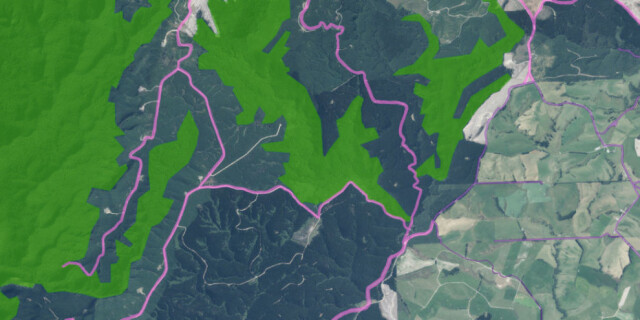Easements
What is an easement?
An easement is a legal agreement recorded on title that allows someone to use part of someone else’s land for a specific purpose — such as running water pipes or walking across it. The land being used is called the burdened land, and the landowner is the grantor. The land that gains from the easement is the benefitted land, and the person or entity that benefits is the grantee.
Easements are spatially defined in land surveys and registered on land titles. Once registered, the rules of the easement can only be changed if both parties agree or if the law changes. The landowner still owns the land and can use it as they wish, so long as they follow the rules in the easement document for the area it covers. The grantee must also follow the rules in the easement document.
Easements that allow public access
Easements that allow public access can be created under different legislation, and each one has its own rules and conditions. It is good to know:
- The legislation that created the easement.
- The specific conditions written in the easement document.
- And the managing authority of the easement (grantee).
When accessing an easement, it is important to check for local signage, look for guidance on government or council websites, or check with managing agencies, as these will let you know of any rules or specific access conditions.
Sometimes public access will be impractical, even if it exists legally.
Types of easements for public access
Walkways (Walking Access Act 2008)
Walkways are publicly accessible tracks on either public or private land. They are established under the Walking Access Act 2008, or one of its predecessors, and declared as walkways in the Government’s official newspaper, the New Zealand Gazette. Gazetted walkways are open to the public. A department (such as Department of Conservation), local authority (district or regional council), or public body (such as Fish & Game), can manage a Walkway.
Public Access Easements (Crown Forest Assets Act 1989)
Public Access Easements (PAEs) were created under the Crown Forest Assets Act to protect public access in commercial forests. These were usually created to allow public access to and from conservation areas.
The Crown Forest Assets Act 1989
Public Right of Way Easements (Land Transfer Act 2017)
Public right of way easements are created under the Land Transfer Act 2017. They most often come under the authority of a council, but can be under another entity. The rules that apply to these easements are in the Land Transfer Act 2017 and Schedule 5 of the Land Transfer Regulations 2018. Older easements created under earlier versions of the legislation may have slightly different rules.
Esplanade strips
Esplanade strips are adjacent to a water boundary and can provide public access rights along waterways (although not always). They move with the water boundary.
The Resource Management Act allows councils to create esplanade strips. They may be created during land subdivision or may be created by agreement. The landowner still owns the land, but public access may be allowed over it.
Schedule 10 of the Resource Management Act contains conditions and prohibitions that all esplanade strips typically include. Councils and landowners may also have agreed to other conditions of access.
Public access to esplanade strips
The Resource Management Act 1991
Access Strips (Resource Management Act 1991)
Access strips are created on a strip of land for the purpose of public access. They are created in accordance with section 237B of the Resource Management Act 1991, for the purpose of allowing public access to or along any river, or lake, or the coast, or to any esplanade reserve, esplanade strip, other reserve, or land owned by the local authority or by the Crown.
Schedule 10 of the Resource Management Act contains conditions and prohibitions that all access strips typically include.
The Resource Management Act 1991
Department of Conservation Easements in Gross
Department of Conservation (DOC) easements in gross are easements granted in favour of DOC for the purposes of conservation management, but which can also provide for public access. Not all DOC easements in gross provide for public access.
These easements can be created under a variety of legislation, including the Conservation Act 1987, the Land Transfer Acts and the Reserve Act 1977.



